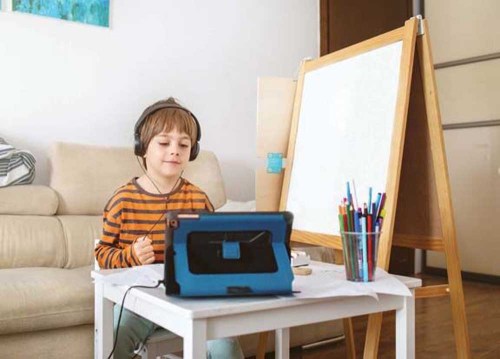Here’s how to ease your child into distance learning
Published 10:21 am Tuesday, September 8, 2020

- Little boy attending online classes from home. Unattended Child using digital tablet and headsets for connecting with teacher and schoolmates. School education and social distance during quarantine
You may have found yourself recently telling your child, “You won’t be going back to school, yet.” Those words may have a multitude of valid feelings attached. Those words lead to uprooting your expectations of how learning happens and planting yourself in new and uncharted territory. Just as a freshly transplanted houseplant needs extra water and nutrients to keep its roots healthy and strong, you and your child may need extra support and love as your roots grow strong in this new space. I’m going to provide you with a few significant ways to offer that extra support and love on your child’s academic journey this school year.
In order to create a predictable environment for learning, it’s helpful for your child to have visual routines. Visual routines remind your child of expectations in words and pictures, and can be referred to as many times as needed. You and your child may find it helpful to create visual routines for asking for help, preparing for learning, cleaning up, and taking breaks, to name a few. Visual routines are especially supportive for troublesome times of the day. You can create a visual routine to support your child while they learn a new skill.
A daily schedule is another example of a visual routine and can be created by you and your child together. In order to build the schedule, write out the important times in the day: math, reading, science, brain and body breaks, etc. You can include the time of day. Last, take a picture of your child performing the activity or draw a picture and add it to the schedule. You can even add in a space to check off when a task is completed!
Another way to support your child’s distance learning is to set up a physical workspace. Make a list with your child of the important components of a productive workspace. Here are a few ideas: a desk, a daily visual schedule, visual routines, pencil, paper, computer, headphones, number line, etc. Next, find a quiet space to fit all of these materials. Bonus if you can find a space near an outlet to charge the computer. If not, make a plan with your child for how they will get their computer charged daily. Wall space will be your friend for hanging visual routines and academic supports like an alphabet chart or number line.
Now that you’ve got a good handle on the physical space, it’s time to learn! Learning happens when our brains are in an optimal state. Brain breaks help to increase attention and are an important way to teach your child to listen to and care for their body. If you or your child recognize times that they often lose focus, add a brain break to the schedule to help regain focus. In the beginning of the year, your child will be building their stamina for learning. They may need brain breaks more often than you or their teacher anticipated. It’s okay to be flexible and give your child a brain break, then make a plan together for building their learning stamina. By October, you’ll be celebrating with your child how much learning stamina they have built!
Brain breaks can include: mindful belly breathing, stretching, moving, playing a game, going for a walk, and connections with other people. Connections with you or other caregivers will be important for your child and may need to happen often. GoNoodle.com is a helpful online catalogue for video-led brain breaks.
Whether your child is enrolled in comprehensive distance learning, an online program, or a hybrid model, this school year is going to present unexpected challenges. Your child’s education will provide plenty of opportunities for mistakes and growth. You have the opportunity to help your child learn and grow through one of the most challenging experiences of their lives. Positive intent is seeing the best in yourself and others. It is my hope for you that you are able to see the best in yourself and your child, as you make mistakes and grow through them. I wish you well as you continue to love and support your child in their learning this school year.
________
Elizabeth Gregory is a teacher with the La Grande School District, a partner of the Blue Mountain Early Learning Hub, which works to bridge early childhood resources and prepare children for kindergarten. For more information visit www.bluemountainearlylearninghub.org.









